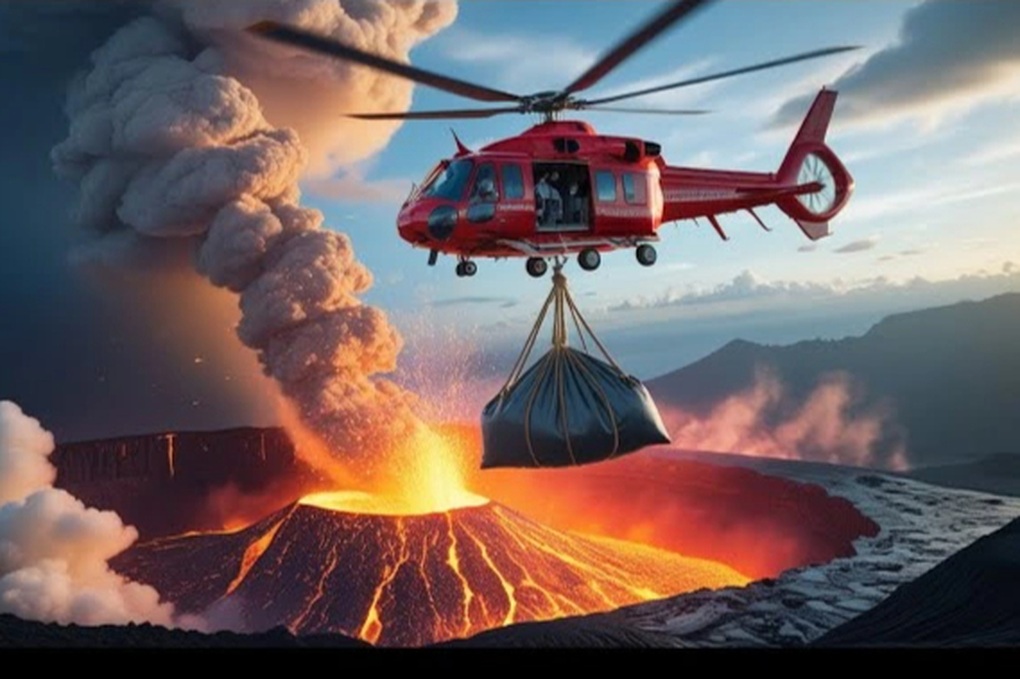Sounds reasonable, but the reality is… a nightmare
Garbage is a global problem with more than 2 billion tons of household waste every year. In an effort to find a radical solution, many people have asked the question: why not take advantage of volcanic craters that are hotter than 1,000 degrees Celsius to burn all the garbage?
According to What If , the idea seems feasible at first: high temperatures can incinerate plastic, rubber, light metals and organic waste in a split second. However, science quickly pointed out a harsh truth: lava, although hot, is not an “unlimited destruction machine”.

In an effort to find a radical solution, many people have asked: Why not take advantage of volcanic craters hotter than 1,000 degrees Celsius to burn all the trash? (Photo: Getty).
The amount of global trash is so enormous that no single volcano can “swallow” it all. Not to mention that transporting trash from all over the world to several active volcanoes is a nearly impossible, expensive, and dangerous logistical problem.
The air will be more toxic, volcanoes may explode
Even if the transportation hurdles are overcome, the prospect of “throwing trash into a volcano” still poses a host of environmental and geological hazards. Unlike modern industrial incinerators equipped with air scrubbing systems, volcanoes spew toxic gases straight into the atmosphere.
Plastic waste and synthetic compounds, when burned in uncontrolled conditions, can produce dioxins and furans, which are potent carcinogens, along with large amounts of greenhouse gases such as CO₂ and methane.
If applied on a global scale, the amount of toxic gases produced would exceed the atmosphere's ability to clean itself, exacerbating climate change.
Not stopping there, dumping cold, wet trash into a boiling lava lake could cause explosive chain reactions.
A 2002 experiment in Ethiopia recorded a small explosion when the research team threw 30kg of garbage into the volcano. Steam from the garbage mixed with lava created a huge pressure increase, pushing the volcano to an unstable state and prone to sudden eruptions.
In addition, toxic substances such as heavy metals, industrial chemicals, and even radioactive substances will not disappear if thrown into the volcano. They can seep into the magma layer and spread when the volcano is active, causing widespread pollution beyond all geographical boundaries.
The solution lies not in volcanoes, but in people.
The idea of using volcanoes as “natural landfills” was once considered by NASA but was quickly dismissed. The reason is clear: it does not solve the root of the problem, but only makes the environmental situation worse and out of control.
The real solution lies within each individual: reducing consumption, recycling, developing biodegradable materials, promoting a circular economy and controlling waste from production.
By reducing the amount of waste from the beginning, people will not have to seek "risky" solutions like leaving it all to lava.
Volcanoes are not “the Earth’s garbage disposal machine”. On the contrary, if handled incorrectly, they can become “poisonous gas bombs” waiting to explode. In the war against waste pollution, not lava, but human thinking and behavior are the most important weapons.
Source: https://dantri.com.vn/khoa-hoc/se-ra-sao-neu-nhan-loai-do-rac-vao-nui-lua-20250905070557818.htm






![[Photo] Secret Garden will appear in Nhan Dan Newspaper's Good Morning Vietnam 2025 project](https://vphoto.vietnam.vn/thumb/1200x675/vietnam/resource/IMAGE/2025/9/19/cec307f0cfdd4836b1b36954efe35a79)
![[Photo] Prime Minister Pham Minh Chinh chairs the sixth meeting of the Red River Delta Coordination Council](https://vphoto.vietnam.vn/thumb/1200x675/vietnam/resource/IMAGE/2025/9/20/310e73a867174433b2c489ec309c9063)























![[Photo] Spreading Vietnamese culture to Russian children](https://vphoto.vietnam.vn/thumb/1200x675/vietnam/resource/IMAGE/2025/9/19/0c3a3a23fc544b9c9b67f4e243f1e165)























![[VIDEO] 50 years of Petrovietnam: Keeping the legacy alive, creating national energy](https://vphoto.vietnam.vn/thumb/402x226/vietnam/resource/IMAGE/2025/9/20/dff4ddb3d15a4076ba5f67fcdc6c7189)














































Comment (0)